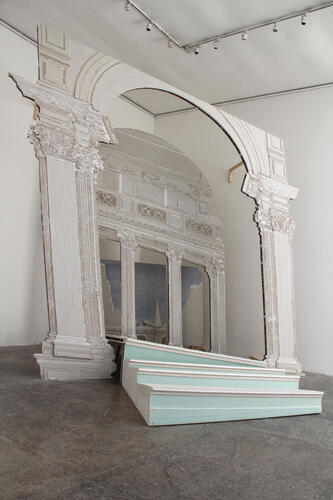Tomás Rivas
AMS Marlborough, Santiago de Chile
The central axis of Tomás Rivas’s oeuvre is architecture, in particular, the way in which a glorious past may be reconstructed and architectural history reviewed. In his best-known work , three dimensional structures −buildings − and two dimensional structures –paintings – are recreated by means of large and laborious murals that make reference to the cycle of construction and destruction, typical of architecture, a contingent occurrence especially in the framework of the vertiginous processes of the urban development of big cities. His work rescues the classical architecture which has been destroyed, or is in the process − or a potential target −of destruction, paradoxically by applying destructive procedures such as cuts and incisions, carvings and openwork on walls.

In his exhibition at AMS Marlborough Gallery, Rivas is presenting a large installation, a video illustrating its construction process, several carved gesso pieces and a mosaic. The centerpiece is titled El banquete de Cleopatra (Cleopatra’s Banquet) and it consists in a three-dimensional rendition of the fresco created in 1745 by Tiepolo, portraying the encounter of Marco Antonio and the Egyptian queen. The installation is made of precarious construction materials and it resorts to architectonic perspective in a dramatic, almost scenographic way. The piece appears as a sort of theater set in which different ornamental and architectural planes and motifs, both classical and neo-classical, converge. Thus, the artist creates an illusion and engages the spectator spatially and temporally, transporting him/her for a few minutes from a contemporary art gallery to a past moment in the history of art.
-
 Cleopatra’s Banquet, 2011. Plaster plaques, expanded pol- yethylene, wood and cardboard, 157.5 x 157.5 x 118 in. AMS Marlborough Gallery. Photograph: Juan José Rivas Courtesy of the artist. El banquete de Cleopatra, 2011. Placas de yeso, polietileno expandido, madera y cartón. 4x4x3m Galería AMS Marlborough. Fotografía: Juan José Rivas Cortesía del artista.
Cleopatra’s Banquet, 2011. Plaster plaques, expanded pol- yethylene, wood and cardboard, 157.5 x 157.5 x 118 in. AMS Marlborough Gallery. Photograph: Juan José Rivas Courtesy of the artist. El banquete de Cleopatra, 2011. Placas de yeso, polietileno expandido, madera y cartón. 4x4x3m Galería AMS Marlborough. Fotografía: Juan José Rivas Cortesía del artista.




